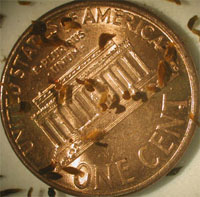
Convoluta convoluta
Platyhelminthes
Convoluta convoluta is an acoel 'flatworm''*, usually 2-4 mm but sometimes to 9 mm, and an oval body shape, but with later edges rolled down, for a C-shaped cross-section. Acoels have a simple body plan, with a mouth and oral cavity. They are hermaphroditic, with paired ovaries and testes, running down the body. Convoluta convoluta is dark green ot yellowish brown in color, due to the presence of symbiotic algae (zooxanthellae). Native acoel 'flatworms' in the Gulf of Maine lack zooxanthellae, but tropical western Atlantic species do have them. Convoluta convoluta is omnivorous, feeding on diatoms, mollusks, and copepods, in addition to nutrition from its zooxanthellae. This organism is known from the northeastern Atlantic from the Barents Sea to the Canary Islands, and into the Baltic and Black Seas. In the Northwest Atlantic, it was first reported from Halifax, Nova Scotia in 1995, occurring on the introduced alga Codium fragile. In 1996, C. convoluta was sound in abundance on macroalgae on the Isles of Shoals, New Hampshire, and by 1999, on sea urchin barrens, off York Beach, Maine. In settling plate experiments, in the Isles of Shoals, C. convoluta could reduce mussel settlement by up 30%, but only under particular conditions of temperature and wave action. The photo, taken by Jeb Byrnes, shows C. convoluta on a penny.
*Acoel 'flatworms' have been traditionally placed in the phylum Platyhelminthes, but are now placed in their own phylum, Xenacoelomorpha (Phillipe et al. 2015; WoRMS Editorial Board 2024). We' will refer them as 'flatworms' for convenience.